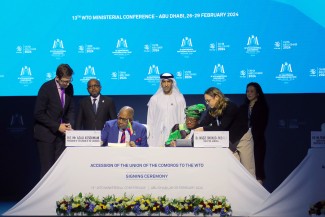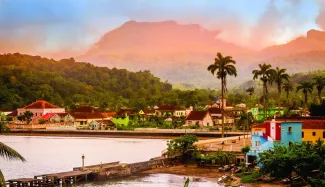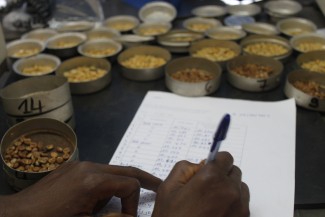In some least developed countries, COVID-19 causing a shift in tourism plans
Lake Assal. The Moucha-Maskali Islands. Lake Abbé. Heard of them?
These are some of Djibouti’s most striking sites, and include Africa’s lowest point and the third saltiest body of water in the world in the frosty blue, crystalline-ringed Lake Assal. But, the tiny, desert country doesn’t exactly draw big tourist numbers, with income from the sector amounting to 1.5% of GDP in 2019, according to the most recent data from the Directorate of Statistics.
Djibouti is a least developed country (LDC), and for many such struggling economies, tourism offers promise of foreign dollars, jobs, better infrastructure and a route out of poverty. In its “Djibouti Vision 2035” plan for economic development created in 2014, the government recognized that promise and made tourism one of its priority sectors. The country is providing incentives for the private sector to invest in tourism like exemption from tax obligations and land at preferential prices, and new hotels that meet international standards have sprung up, and other internationally branded hotels are under construction.
Farther south, another LDC also set its sights on tourism. Comoros, although blessed with tropical landscapes and craggy black volcanic shores, also does not have a huge tourism market. The country’s National Tourism Office was implementing its own action plan to spur more tourism and to run through 2021.
Then COVID-19 happened.
“As early as 29 March 2020, the President announced COVID-19 officially. The protection measures had catastrophic effects on the tourism industry; 99% of employees were on technical lay-offs. During the containment period, we had 0% international tourism,” said Azali Azali Said Ahmed, Communications and Marketing Director of Ecotourism House Ngazidja, an office that promotes community-based and eco-tourism in Comoros.
The governments of both Djibouti and Comoros shifted their strategies, including taking a fresh look toward their own citizens as domestic tourists. Although the market may have changed, the pivot meant that burgeoning tourism sites and strategies could continue to be developed and refined while borders were closed.
“The National Tourism Office of Djibouti launched a visibility campaign on social media to promote Djibouti as a tourist ‘destination’ to the population. This was done to promote local tourism to counteract the absence of international tourists,” said Kadoug Ibrahim Houssein, Communication and Marketing Head at the National Tourism Office of Djibouti.
“Djiboutians normally go out of the country for tourism, so the strategy was to make them rediscover the wonders of their country,” she said.
For many LDCs, community and nature-based tourism are areas of competitive advantage as travelers increasingly search for experiences outside the traditional hotel and attraction zones. Post COVID, geographies with open spaces, natural parks and distance from other humans may be the most desired – and many LDCs fit the bill.
“A marketing plan for the tourism industry was published a few months ago for the government to drive tourism. The marketing will focus on the beach sites, which will push us to clean them up. The plan also focuses on the promotion of flower villages, or places adorned with floral arrangements, and we have different strategies to attract the school and business world,” said Ahmed.
Comoros has seen an increase in local tourism as a result.
He described work to develop ecotourism and to promote Comorian culture. He described packages for agrotourism, including a vanilla package, a ylang-ylang package, an adventure package and a gastronomic package.
“We consider that we are in a phase of preparation for the recovery of tourism,” Ahmed said.
That recovery includes new safety standards as the world strives to recover its health and economies. And they are eyeing markets in the region like Reunion, Mayotte and South Africa, and tourists farther afield from France and Italy, Canada and the United States, and China and Japan.
“At the moment, the tourism sector has to be better prepared to offer safer tourism activities. This includes safety protocols in restaurants, hospitality and other activities. Outdoor activities such as ecotourism, natural parks, etc. are also more favored,” said Zoritsa Urosevic, Director of Institutional Relations and Partnerships at UNWTO.
Djibouti, which boasts swaths of desert landscapes and camping under vast, un-light polluted skies, might just offer those options.
They have trained tourism workers in best pandemic-era practices that align with health protocols, and hotels have worked to ensure new barrier measures and COVID protections are in place.
In Comoros, they are eyeing the development of new kinds of places to stay, working with mayors so they are prepared to welcome tourists post COVID.
“We have beautiful houses left by our diaspora, so we are looking to introduce homestay tourism,” Ahmed said.
It is that diaspora that they are also looking to welcome back, as tourists.
“We will target the Comorian diaspora populations who will return to Comoros for holidays such as Easter. We want to organize activities with the young diasporas to help them discover their country. There are strong Comorian communities in France, Canada and the US,” she said.
The return of international visitors to tourism destinations is also an important trade consideration.
“When it comes to markets, it is a really a question for individual countries who need to look at who their source markets are. As we know, international tourism is trade,” Urosevic said.
“Countries have been trying to find solutions with bilateral agreements with other countries, which are their main markets, so that they can have harmonized protocols, an acceptable level of safety and this helps in receiving clients or tourists from neighboring countries, which are the main markets,” she said.
Such agreements between two countries are sprouting up all over, with health corridors regulated by countries and the World Health Organization.
Djibouti and Comoros are continuing to look both inward and outward to spur economic development and their homegrown tourism sectors.
“What has changed is our approach to tourism promotion. Since our target audience is a national audience, we had to lower the prices of tourist attractions, hotels or tourist packages to make them accessible to Djiboutians. We therefore collaborated with hotel managers who agreed to participate in this initiative in order to give a preferential price to Djiboutians,” said Houssein.
Djibouti is eyeing international tourists from one of its main markets of France, as well as unexplored new markets like Ethiopia, China and Germany.
International support is another way to help LDCs in their efforts to draw tourists. The UNWTO, for example, helps governments with policies, and creates tools so countries can get inspired and create their own models. Under COVID-19 recovery, UNWTO has released a Tourism Recovery Technical Assistance Package to offer guidance to Member States in response to the pandemic. The package is structured around three main pillars: economic recovery, marketing and promotion and institutional strengthening and resilience building.
Before the pandemic, the Enhanced Integrated Framework (EIF) was working with countries that had identified tourism as a sector with potential for development, helping them create national tourism strategies. Support also included trainings on tourism-related skills like marketing. After the pandemic struck, EIF started supporting countries to redirect efforts to domestic tourism and ensure their burgeoning industries adhere to sanitary standards.
“We recommend strongly the uptake of IT skills training, because if young people are trained, you can go on the market much more efficiently. You then have resources to support the tourism industry and the SMEs investment because it reduces costs. It also allows you to be more marketable,” Urosevic said.
With Djibouti and Comoros building up tourism-related expertise that is creating a safe place for domestic visitors alongside the countries’ geographical and cultural distinctiveness, the work over the past year is hopefully setting the stage for strong livelihoods from a fresh, international tourism sector.
I mean, where else in the world can you join a ylang-ylang tour?
If you would like to reuse any material published here, please let us know by sending an email to EIF Communications: eifcommunications@wto.org.



